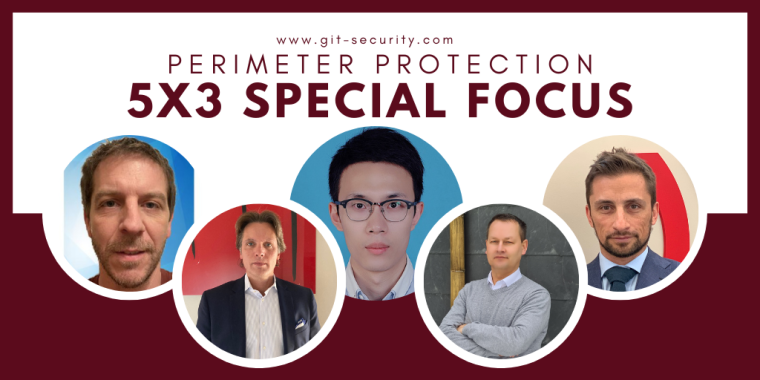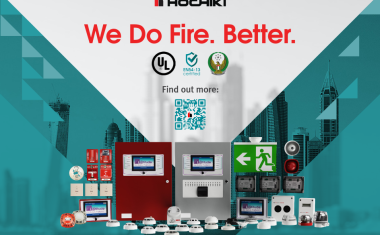Three Questions for Five Experts: Perimeter Protection
In this series, GIT SECURITY EMEA ask three questions to three industry experts about the issue's special focus. This time we asked five experts for their view on perimeter protection.

1. What technology or combination of technologies do you recommend for an effective perimeter protection?
2. What do you see as the biggest challenge in perimeter protection and how do you approach this challenge?
3. Please describe one highlight of your product offering with the best performance for perimeter protection?
Fabrizio Leonardi, Executive Vice Managing Director of CIAS
1. There is not a single technology that works perfectly for any type of environment. Today we can deal with external protections with four macro types of products: barriers, electronic fences, underground sensors and video analytics. Whatever solution or technology was chosen for the realization of the security system, it would have advantages and disadvantages, both of a technical and economic nature. Therefore, to answer the question It will be necessary to work on a rather articulated answer. In fact, only after a careful analysis of the site/risks, it will be possible to hypothesize the achievement of the best cost/performance. Surely the integration of more technologies will allow a reliable detection with few unwanted alarms.
2. In recent years, the security market has rapidly changed skin with the entry of large international players who have speeded up the development process of new technologies. CIAS has always focused and continues to do so on innovation and quality. We have done this since the 90s with the implementation of Fuzzy Logic analysis within our products, or in 2012 with the introduction of MEMS technology for the detection of cutting and climbing fences, we are doing it with Micro-Ray and his linear microwave rays, and we will do it by going deeper into the world of CCTV and video analytics with Synapses.
3. Micro-Ray is a virtual detection barrier with linear microwave rays. The idea was born from the need for an alternative to infrared beams, which are normally used to protect very narrow corridors, but which by their nature have many limits (temperature, glare, solar reflections, fog, high consumption, frequent maintenance). Micro-Ray provides linear rays exactly as infrared does but without the limits of the latter. The flexibility of application for this new technology, thanks to their detection reliability and total immunity to extreme weather conditions, makes this product a unique solution of its kind.
Heiko Viehweger, Sales Manager DACH at Sorhea
1. There is no miracle solution and no panacea in the field of perimeter protection, as each technology has its advantages and its limits. Choosing the right solution depends on: The threat & security risk, the environment, the value of goods and information to be protected and the site infrastructure. Depending on the above points, our experts work in collaboration with our customers to establish a security concept with a single or multi-layered approach. Our goal is to advise on the best mix of technologies that can be used to protect the different zones of a site i. the perimeter, ii. the inner area, iii. the buildings. Sorhea’s shock detection cables can be installed on the perimeter fence in combination with our active infrared barriers and video analytics for the inner layer. Buildings can be secured with our dual-technology motion detectors, or active infrared barriers installed on the façade or roof-top of the building.
2. The biggest challenge in perimeter security is providing an alarm when you need an alarm 24/7 and 365 days a year. When end-users invest in a perimeter security system, they expect to get an alarm when they need an alarm, not when the weather is bad or when small animals pass through the detection zone. We approach this challenge with innovation and technology. Providing reliable solutions is Sorhea‘s DNA.
3. Sorhea is the only manufacturer of active infrared barriers capable of providing an immaterial wall of detection of up to 18 active infrared cells and 5m in height. Sorhea‘s multiplexing technology allows you to know exactly which beam(s) is/are cut. Our customers can configure the barriers to trigger an alarm if one, two or three parallel beams are cut, thus filtering unwanted alarms from birds or flying objects. In short, we maximise the power of detection as well as minimising unwanted alarms at the same time.
Bangyan Xu, Product Manager of Security Radar at Hikvision
1. The perimeter environment is usually complex with changeable weathers, while different types of events could happen from time to time. It is crucial for security systems to be stable and reliable protecting perimeters. However, in most cases, security technology with a single-dimension could not fully detect the anomalies effectively. Hence, we suggest to adopt technology with multi-dimensional perception, and in the case of perimeter protection, it would be the combination of video cameras with radar technology. This integration extends perception capabilities of radar sensor and video cameras and widens their applications by enabling the collection and use of multi-dimensional information. Security radar is reliable in all weathers and lighting conditions, it provides wide detection angle and ultra-accurate intruder detection capabilities. It can further offer visual intruder verification through video linking. This configuration will not only trigger an alarm when an intruder is detected – it will also trigger video recording, to help with visual verification of the intruder. This helps create ultra-accurate intrusion detection in all weathers, increasing operational efficiency and providing maximum security to perimeter environments.
2. The biggest challenge would be the complex environment and harsh weathers, and to gain maximum reliability (of the technology) in such conditions, those include but not limited to complete darkness, dense fog and stormy weathers. Therefore, we need to address it with overall situational awareness of the perimeter, predict and cope with events effectively and efficiently. We suggest security radar and its linked PTZ dome cameras as a solution. The reasons are: Most radar units use microwave frequencies to detect and measure objects, they do not rely on lighting for perception, therefore, they can be hardly impacted by darkness, rain or fog. While this kind of environment is especially true for perimeters, so implementing radar technology can greatly improve the overall system stability.
A security radar allows the measurement of the radial distance and the depth of each object, it accurately maps out the location and distance of an object in the detection field, which can be used to predict potential risks and strengthen the overall situational awareness of the environment. The combination of radar and video cameras can further provide visual images of intrusion events, helping operators to verify alarms, hence greatly boosts overall system’s alarm accuracy and strengthens system reliability.
3. Our DS-PRI120 microwave security radar uses cutting-edge Hikvision technology to accurately pinpoint the location and motion trail of up to 64 potential intruders per radar, even in the harshest weather conditions. It can offer accurate detection over a wide angle of 120°, and up to a distance of 120m. It supports multiple scene modes with adjustable sensitivity, making it suitable for a variety of applications. Shrub Mode, for instance, is best suited to areas surrounded by dense forest, as it reduces false alarms such as shaking trees or heavy rain. Open-Area Mode is ideal for large, open, sensitive locations such as ports and parking lots. And the Custom Mode enables users to fine-tune the environmental sensitivity to suit their particular needs. The radar can also link with as many as four Hikvision PTZ dome cameras at once, enabling users to view, accurately track and record multiple images of targets simultaneously.
Rick Wakeham, Technical and Product Manager for Optex (EMEA Region)
1. Effective perimeter protection requires a combination of physical and electronic security components working together, from security fences and intrusion detection systems to access control and intelligent video surveillance. We recommend different intrusion detection technologies depending on perimeter types and the level of threat. To detect people trying to climb over, crawl under or cut through a security fence, for example, fibre optic detection systems provide a reliable, long-term solution, with zones determined to match camera views. To provide pre-warning areas when people or vehicles are getting too close to the perimeter line, or to create an additional security layer to walls or fences detecting a person crawling towards it or jumping over it, our LiDAR technology would be the perfect choice. It also performs well in applications where you need to secure access gates.
2. I see two big challenges: first the fact that perimeter protection takes place in an outdoor environment which constantly changes; and second that while the solution needs to work effectively it also needs to be flexible so as not to impact business operations. The environmental factors should be assessed for each site: weather, for example, changes through the seasons; wildlife and vegetation within the surrounding area also needs to be considered. The right technology and configuration should be chosen accordingly. Understanding the operational requirements is crucial to avoid a security system that becomes detrimental to the business operations.
3. If we are looking at our Redscan LiDAR product, a performance highlight is its precision, and ability to track an intruder using integrated X&Y coordinates from the moment an intrusion is detected. It is also precise in determining the size of the object detected; the object target size can be adapted to different threats: detecting people and ignoring wildlife for instance, or detecting a vehicle but not a person etc. Precision is also assured through its ability to create a number of independent detection zones with different sensitivity and responses.
Sebastiano Vento, Managing Director Sicurit, Perimeter Protection Systems
1. The combination of technologies has always been at the heart of Sicurit concept, either in terms of individual product (Sicurit has been pioneer in dual technology concept applied to a single product for external applications (Dual Technology barrier Absolute, ed.) but more over in terms of multiple protection layers. The layers can be considered as concentric rings of protective measures surrounding an asset. The idea is that if one protective measure is avoided or defeated, additional measures will still be in effect. This concept is often applied to protect Critical Infrastructures.
2. On the one hand our daily challenge is to keep improving our technologies and their ease of installation, enriching with tools to better support on both management and integration levels. On the other hand it is to keep educating the market about the importance of Perimeter Intrusion Detection Systems (PIDS) specially when it comes to protect Critical Infrastructures being the first line of defense. Last but not least new technologies have „wrongly“ entered PIDS landscape, while their applications should be more oriented towards movements area monitoring applications, therefore we recommend always to make sure that technologies implemented fully meets European standards for Alarm Systems (EN50131) granting at least Grade 3 (most Sicurit PIDS meet Grade 4, ed.)
3. As we mainly address our products for the protection of Critical Infrastructures, since the beginning Sicurit has designed its products to meet the highest security standard. Our latest range of IP Native Active barriers, that include Infrared and Dual Technology barriers (Avantgarde and Absolute PRO, ed.) , beside the introductions of our patented bi-directional Infrared Technology that definitely brought our active barriers to a next level, have first introduced unique tools to support, as previously mentioned, both management and integration. These include Predictive Maintenance tools, complete real time diagnostic and applications to connect directly to main VMS and PSIM platforms.















